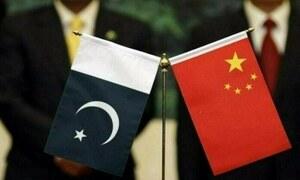ISLAMABAD: Pakistan’s total installed electricity capacity stood at 42,131-MW as of March 2024 with percentage shares of hydel, nuclear, renewable, and thermal at 25.4 percent, 8.4 percent, 6.8 percent, and 59.4 percent, respectively.
According to Economic Survey 2023-24, the share of thermal power as a dominant source of electricity supply has declined over the past few years, showing an increased reliance on indigenous sources. Out of total electricity generation of 92,091GWh, the share of hydel, nuclear, and renewable stands at 54.1 percent, which can be taken as a good sign for the economy, as the sources of electricity generation are shifting from thermal to cleaner sources.
During FY2024 (July-March), total electricity consumption was reported at 68,559 GWh (Table 14.3). The household sector is the largest consumer of electricity, consuming 33,737 GWh (49.2 percent), followed by the industrial sector with 18,022 GWh (26.3 percent). Moreover, agriculture and commercial sectors consume 6,905 GWh (10.1 percent) and 5,365 GWh (7.8 percent), respectively, whereas the electricity consumption in other sectors (streetlights, general services, and other government) is 4,530 GWh (6.6 percent).
The burgeoning burden of capacity payments
Under the short-term targets, apart from opening new investment landscapes in Thar Coal and Hydel power generation in accordance with the power demand-supply scenario under the Integrated Generation Capacity Expansion Plan (IGCEP) 2022 and policies in vogue, PPIB is striving to complete 12 ongoing IPPs of 1,563-MW during 2024-26.
PPIB is actively processing a diversified portfolio of IPPs (Wind/ Solar/ hydel/ Bagasse/ Coal and Gas) under the provisions of Power Generation Policy 2015, Alternative and Renewable Energy (ARE) Policy 2019, and National Electricity Policy 2021. PPIB has achieved significant accomplishment for the implementation of various advanced staged IPPs during the July-March FY 2024.
As of March 2024, net metering-based solar installations stand at 117,807 with a cumulative capacity of 1,822-MW. The number of active certified installers has surpassed 400.
To prioritise indigenous and renewable resource-based power generation, Indicative Generation Capacity Expansion Plan (IGCEP), has targeted increasing the share of Renewable Energy (RE), including hydropower, from 33 percent to 62 percent by 2031.
In this regard, the following measures have been taken in the ongoing fiscal year: (i) development of solar PV Project under Fast Track Solar Initiatives 2022 (600-MWp and 50-MWp Projects at Kot Addu/ Muzaffargarh and Manjhand); (ii) development of RE projects under G2G mode (600-MWp and 1200-MWp projects at Jhang& Layyah); (iii) Small-scale Solar PV project at 11 KV level through competitive bidding by Discos; (iv) constraints in power evaluation capacity and transmission line development are among the power sector’s top priorities, and PPIB plans to carry out competitive bidding for private sector investment in transmission lines.
For the promotion of local resources for power generation, PPIB has already imposed a moratorium on the processing of new imported fuels-based power projects since 2016. Further, due to the increased price of imported coal in the international market, the government of Pakistan took the initiative to substitute imported coal-based IPPs with Thar coal which is abundantly available. In this regard, a feasibility study has been conducted to convert imported coal-based IPPs to Thar coal. Efforts are underway to start the blending of Thar Coal by three imported coal IPPs with a cumulative capacity of 3,960-MW, including 1,320-MW Sahiwal Coal Power Project, 1,320-MW Port Qasim Coal Power Project, and 1,320-MW Hub Coal Power Project.
These initiatives will reduce electricity generation costs, lower tariffs, and save valuable foreign exchange.
The economic survey says that Pakistan became the 15th country worldwide to install an NPP when the 137-MW Karachi Nuclear Power Plant (KANUPP) went operational in 1972. The plant’s economic life assessment was 30 years; however, it operated for around 50 years under the supervision of the Pakistan Atomic Energy Commission (PAEC) and finally shut down in August 2021.
For almost three decades after the start of the KANUPP, international embargoes on transferring civil nuclear technology to Pakistan restrained the expansion of nuclear energy generation capacity in the country. Steady efforts regarding technology and manpower development have resulted in the addition of six NPPs with 3530-MW capacity in Pakistan’s power system. Units (C1 and C2, each of 325-MW, and C3 and C4, each of 340-MW) are currently operational in Chashma, Mianwali, while two plants, each with a capacity of 1100-MW, are operational in Karachi. While KANUPP was a Pressurized Heavy Water Reactor (PHWR) constructed with the help of Canada, the new generation of nuclear plants are all Pressurized Water Reactor (PWR) designed and built with the assistance of China. One more PWR plant of 1200MW capacity is in the initial phase of its development at the Chashma site, called C-5.
It says that a unique characteristic of a PWR NPP is that once fuelled, it can produce electricity at total capacity for around 14 to 18 months. This is called one cycle of electricity production. Fuel is only added during break time between these cycles. This not only makes them invulnerable to short-term energy price fluctuations but also a source of secure energy supply to the grid.
These attributes of nuclear power technology ensure a high availability of NPP. The six NPPs supplied about 16,753 million units of electricity to the national grid during July-March FY 2024. During this period, the monthly share of nuclear in the generation mix remained between 12.8 percent and 25.8 percent.
Copyright Business Recorder, 2024





















Comments
Comments are closed.